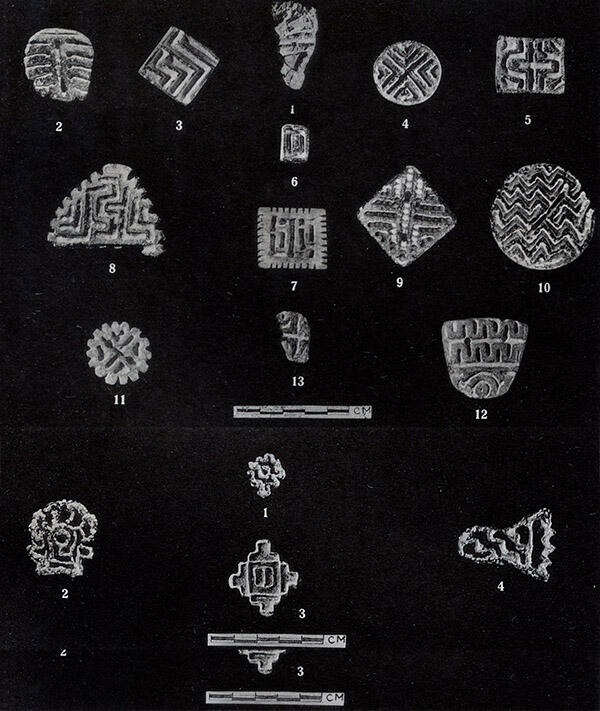The center stone button seal is from Period IV (2900-2400 BCE), while the right most stone button seal is similar to ones from Period II (3500-3400 BCE) and Period III (3400-2900 BCE).
"Stone seals appear in Mundigak in their most crude form of Period II [3500-3400 BCE]. They are flat and carry two perforations intended for a hanging cord. More elaborate, but still adorned with geometric designs, they multiplied in the following periods. Copper seals compartments, carrying on the reverse a perforated boss, will appear only when Mundigak is transformed into a small town." ("Mundigak," an article by Jean-Marie Casal, in Archaelogia Nov-Dec 1966, p. 32)
Casal further wrote: "Despite all these achievements, Mundigak lacks an important element of those that characterize an urban civilization: writing. We have never in fact discovered any document written in this point situated between the civilizations of the Middle East and that of the Indus which, at that time, had a fixed writing system. . .. It is also from Tepe-Hissar that come the compartmentalized copper seals with a small handle on the back. Appearing rarely from the first city levels, they will be found during its reconstructions in greater numbers side by side with the traditional stone seals." (La Civilisation d l'Indus et ses enigmes [The Indus Civilization and its Puzzles] 1969, p. 68)
Asko Parpola in his overview Seals and Sealing in the Ancient World (2018, p. 130-131) discusses the Pre-Harappan Phase ca. 3500-3000 BCE in the evolution of Indus seals types and motifs: "For the Pre-Harappan and the first part of the Early Harappan Phase this sketch is based on Akinori Uesugi's recent paper (2011). During the latter half of the fourth millennium BCE the regional cultures of the Greater Indus Valley reached a high level of development, and interregional interaction began. Round, square and rectangular button seals with geometric motifs and two holes in the middle for threading [see round seal above] are attested from Mehrgarh IV [3500-3000 BCE] and V [3000-2750 BCE] in Baluchistan. They have close parallels on the Iranian Plateau, especially at Shahr-i Sokhta II [2800-2500 BCE] in Seistan [Iran] and at Mundigak III in southern Afghanistan. One (broken) bone seal of this type (H-1521) comes from Harappa I.
"An ivory seal from Rahman Dheri IB [3000-2750 BCE] has two holes in the middle but figurative motifs (including a pair of scorpions). The early seals at Mehrgarh were found in compounds dedicated to crafts activities and possible storage (Frenez 2004); this is compatible with the evidence of the earliest seals from Harappa (Meadows and Kenoyer 2010)."
Image 2: Seals from different levels. A Stone seals. B Copper seals. (Casal, Fouilles De Mundigak, 1961)




